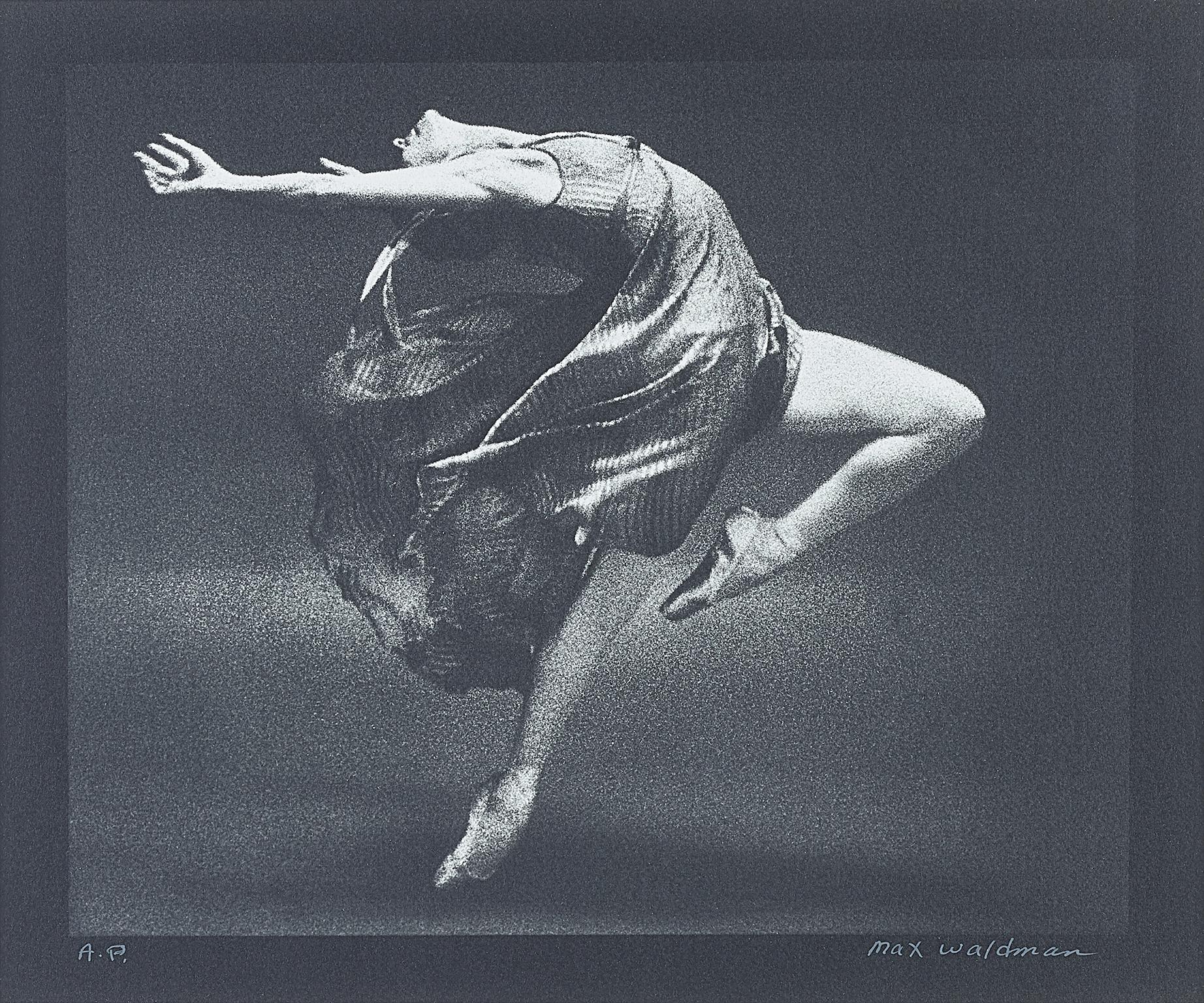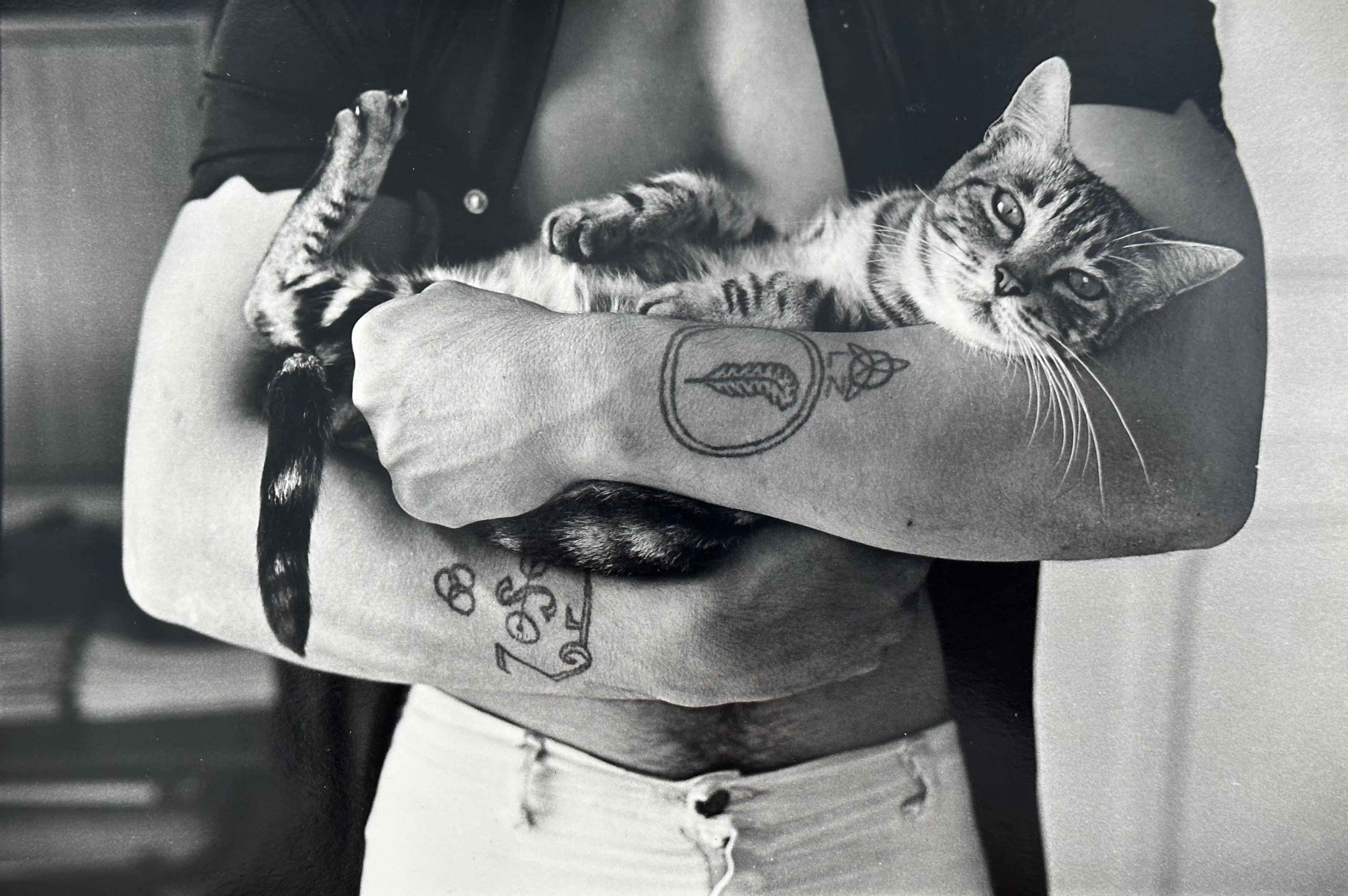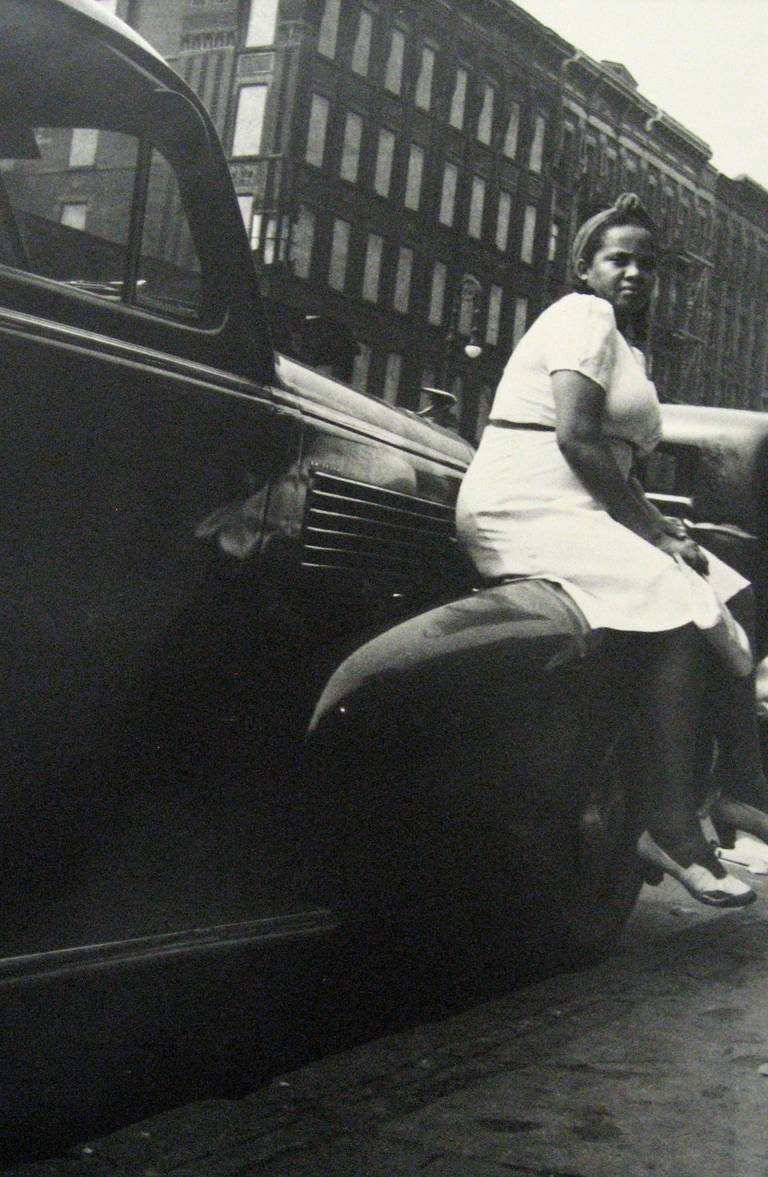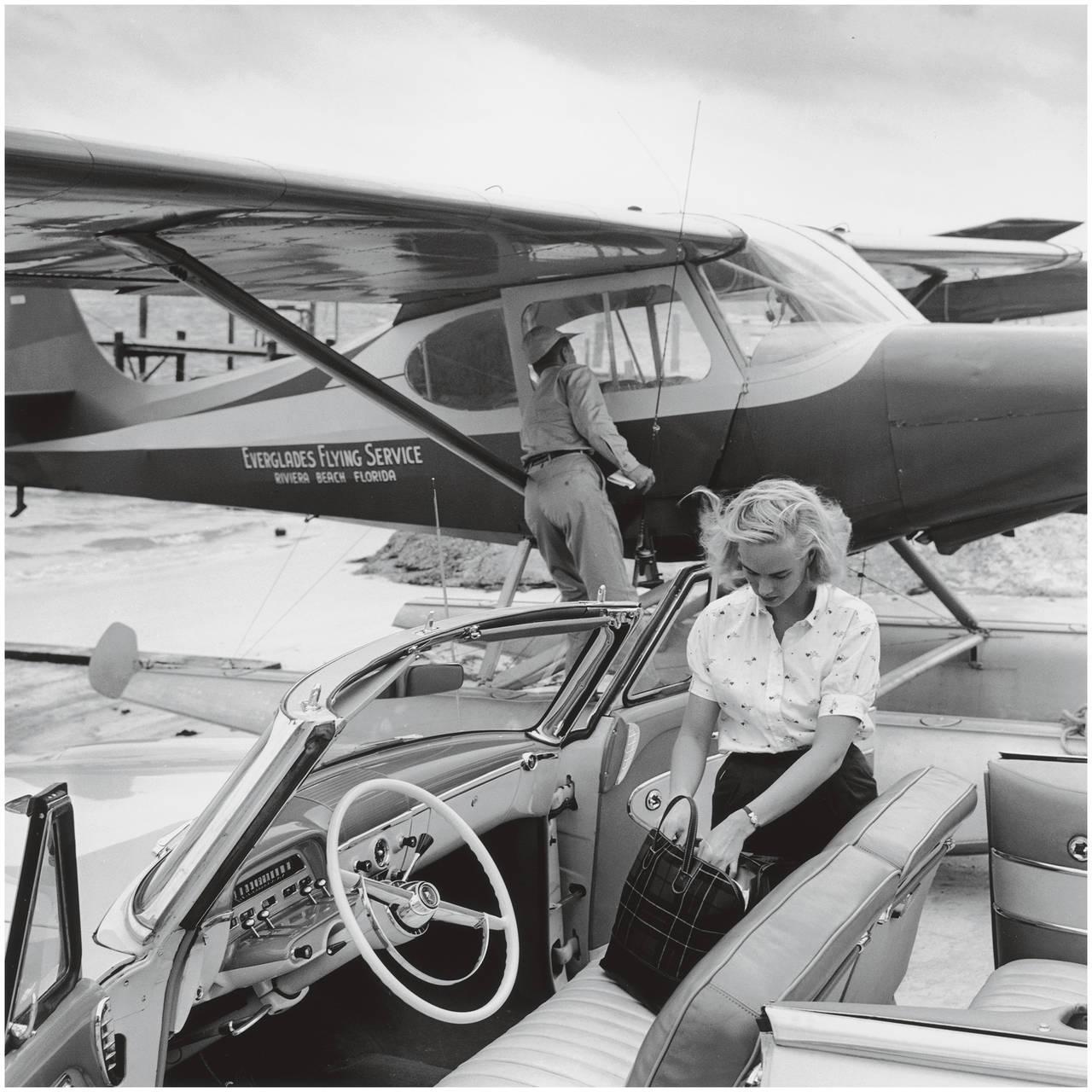Items Similar to Shaker Interior, Sabbathday Lake, Maine
Want more images or videos?
Request additional images or videos from the seller
1 of 10
George TiceShaker Interior, Sabbathday Lake, Mainec. 1971
c. 1971
About the Item
Shaker Interior, Sabbathday Lake, Maine
Silver print, selenium toned, 1971
Signed in pencil lower right (see photo)
Titled verso (see photo)
Printed c. 1971
Condition: Excellent
Image: 6 1/2 x 9 3/8 inches
Frame: 14 x 17 inches
Original Kulicke welded frame
George A. Tice, born in Newark, New Jersey, United States, October 13, 1938, the son of a college-educated New Jerseyan, William S. Tice, and Margaret Robertson, a Traveller of Irish, Scottish, and Welsh stock with a fourth-grade education. George was raised by his mother, maintaining regular visiting contact with his father, whose influence and advice he valued highly.
Education
His first contact with photography was in the albums of family photographs belonging to his father, and this gave him the desire to create images of his own. George Tice began with a Kodak Brownie. In 1953, having bought a Kodak Pony, which gave him some control over exposure and focus, and a Kodak developing kit, he began to advance his craft. George Tice also joined the Carteret Camera Club. Tice's photographs of homeless men on the Bowery won second place in the black and white print competitions. George Tice decided at this point to make photography his career.
In 1955 George Tice attended the Newark Vocational and Technical High School, where he briefly studied commercial photography under Harve Wobbe. When he turned sixteen, he quit school and took a job as a darkroom assistant for Classic Photo, a portrait studio in Newark. He also worked as a stock boy at Kreske's Department Store in Newark, then as an office boy in the circulation department of the Newark Evening News.
In 1956 George Tice enlisted in the United States Navy, in which he rose to the rank of Photographer's Mate Third Class. After boot camp and two years at Naval Air Station Memphis, he was transferred to sea duty aboard the aircraft carrier, USS Wasp (CV-18).
Career
In 1960, now a civilian, George Tice joined the Vailsburg Camera Club and took a job as a family portrait photographer for Americana Portraits. That same year he began to make short trips to Lancaster County, Pennsylvania to photograph the Amish and Mennonite communities, using 35mm and medium format cameras. In 1964 George Tice began his series of tree photographs. By then he had learned all he could from the disciplines of the camera club and brought his involvement to an end. George Tice had his first solo exhibition at the Underground Gallery, New York and then decided to move with his family to California, where he continued his work in family portraits, but pursuing artistic projects like his series on the ghost town of Bodie, California on the edge of the Sierra Nevada range.
In 1967 George Tice bought a 4 x 5 Deardorff view camera and made studies of ice formations. In the same year, he traded in his 4 x 5 for an 8 x 10 view camera and began his aquatic plant series. He also produced his first photographs of Paterson, New Jersey, which became the subject of two books and exhibitions, Paterson and Paterson II.
George Tice met Lee Witkin in 1968 and used his knowledge of photography and its history to help him establish the Witkin Gallery in New York, one of the first successful galleries of photographic prints as fine art. He issued the portfolio, Trees, taught a workshop at Aspen, Colorado, and began to experiment with platinum printing, a lost art since the First World War. Tice's experimentation with early photographic processes continued in 1972 with his creation of a photogenic drawing of leaves printed in a contact frame exposed to sunlight onto hand-sensitized paper coated with diluted silver nitrate, in the manner of William Henry Fox Talbot, producing a Calotype negative.
In 1970 he began photographing coastal Maine this year and began teaching at the New School for Social Research. That year he also traveled to London and Paris with Lee Witkin in search of material for the Witkin Gallery. In 1971, Tice issued his portfolio, Bodie, with an introduction by Lee Witkin, printed an Evans portfolio from lantern slides, and published, again with Doubleday, Goodbye River Goodbye, with poetry by George Mendoza. In 1972 Life magazine sent him on assignment for the article "Home to Iowa."
Over the next decades, George Tice developed as a photographer - historian - a quality he had already shown in his interest in the history of photography as a collector and in his study and adoption of historical techniques.
Around 1976/77 George Tice acquired a Fujica soft-focus lens, and in this, he found another avenue to explore the history of photography and to invent it once again for his own artistic purposes. Over the next two years, he made a series of soft-focus photographs of a girlfriend, Deborah, and three white cats, which belonged to one of his daughters.
In 1982 George Tice printed a Steichen portfolio, Steichen: Twenty-Five Photographs, and another retrospective monograph, Urban Romantic: The Photographs of George Tice, issued by the esteemed publisher, David R. Godine, marking the beginning of Tice's aim to attempt to equal the quality of his original prints in his books. In 1983 George Tice turned to a new subject closely related to Lincoln. He traveled to the Midwest to photograph James Dean's Fairmount, Indiana, Ronald Reagan's Dixon, Illinois, and Mark Twain's Hannibal, Missouri. His fascination with legendary American men inspired him not only to seek out remembrances on every street corner but to go to the home towns of three Americans who rose from ordinary beginnings to set a historic stamp on society and culture.
George Tice had developed into a creator of books as a writer and editor as well as a photographer. He also regularly taught photography classes at numerous institutions including the Maine Photographic Workshop in Rockport, Maine, and Appalachian Photographic Workshops in Asheville, NC.
The following year, George Tice visited the U.S.S.R. on a cultural exchange, leading a group of American photographers together with Cole Weston and made some photographs, primarily street portraits. George Tice returned to the urban landscapes of New Jersey in 1994, when he began a project that was published eight years later as George Tice: Urban Landscapes. In 2006 he traveled to Belgium to work with Georges Charlier of Amanasalto for the production of Paterson II.
In 2010 filming began for a documentary about his career, George Tice: Seeing Beyond the Moment, by New Street Productions, premiered in 2013 at the Newark Museum as part of his seventy-fifth birthday celebrations, which included exhibitions at William Paterson University, The Newark Museum, the Scott Nichols Gallery, the Nailya Alexander Gallery, and the Point Light Gallery.
Achievements
• George Tice was established as a major figure in black and white fine art photography. He received fellowships from the National Endowment for the Arts and the Guggenheim Foundation. He was established as a classic observer of the American landscape, both urban and rural, and the world of the working American.
George Tice was inducted into the New Jersey Literary Hall of Fame and awarded the "Michael," a prize designed by Michael Graves. In 1990, George Tice received a joint fellowship from the National Museum of Photography, Film, and Television (now the National Media Museum) in Bradford and from Ilkley College, Ilkley in Northern England.
In October 2015 the Lucie Foundation honored George Tice with their Lucie Award for Lifetime Achievement at Carnegie Hall.
Courtesy Prabook
- Creator:George Tice (1938, American)
- Creation Year:c. 1971
- Dimensions:Height: 14 in (35.56 cm)Width: 17 in (43.18 cm)
- Medium:
- Movement & Style:
- Period:
- Condition:Silver print, selenium toned.
- Gallery Location:Fairlawn, OH
- Reference Number:
About the Seller
5.0
Recognized Seller
These prestigious sellers are industry leaders and represent the highest echelon for item quality and design.
Platinum Seller
These expertly vetted sellers are 1stDibs' most experienced sellers and are rated highest by our customers.
Established in 1978
1stDibs seller since 2013
711 sales on 1stDibs
Typical response time: 1 hour
Associations
International Fine Print Dealers Association
- ShippingRetrieving quote...Ships From: Fairlawn, OH
- Return PolicyA return for this item may be initiated within 10 days of delivery.
More From This SellerView All
- Marilyn Monroe, Glass Balanced on Left KneeBy Milton GreeneLocated in Fairlawn, OHFrom: The Black Sitting, 1956 Original silver print photograph taken the the photographers studio in New York in 1956. Hand signed in ink within the photographers stamp verso. Pri...Category
1950s American Modern Figurative Photography
MaterialsSilver Gelatin
- Dante's View, Death ValleyBy Edward WestonLocated in Fairlawn, OHDante's View, Death Valley Gelatin silver print, 1938 Unsigned Signed with the estate stamp verso (see photo) A lifetime printing by Brett Weston (1953-19...Category
1930s American Modern Landscape Photography
MaterialsSilver Gelatin
- New York #121By Jed FieldingLocated in Fairlawn, OHNew York #121 Silver Gelatin print, 1980 Signed in ink below the image (see photo) Annotated verso in pencil: "New York #121 ©, New York, 1980" (see photo) Provenance: Reader's Digest Association Collection #23214 (label) Condition: Excellent Image size: 12-5/8 x 18-3/4" (32 x 47.6 cm.) Mat size: 19-1/2 x 25-1/2" Photographs by Fielding are in the collections of: Museum of Modern Art Brooklyn Museum International Center of Photography (New York) Museum of Contemporary Photography (Chicago) Art Institute of Chicago Walker Art Center (Minneapolis) Center for Creative Photography (Tucson) Fielding was born in Boston, Massachusetts. He attended the Rhode Island School of Design, where he studied with photographers Aaron Siskind and Harry Callahan; he received his BFA in 1975. He received his MFA in 1980 from the School of the Art Institute of Chicago, where he studied with photographer Kenneth Josephson. He has photographed in such countries as Italy, Peru, Spain, Greece, Egypt, Mexico, Portugal and the United States. His work has particularly concentrated on the Italian cities of Rome and Naples, as well as Mexico City. Of Fielding's City of Secrets, critic Vince Aletti wrote: [Naples'] citizens, from wiseass kids in diapers to weathered old men, loom into the frame like characters out of Fellini, bursting with antic, earthy energy. Fielding confronts and embraces his subjects, building up a portrait of a place that's as visceral as it is cinematic--a true theatre of the streets. Photography curator and collector W. M. Hunt wrote about the book: Jed Fielding is from the old school: a photographer with vision and technique. I've been to Naples twice in my lifetime; once by ship, and, even more lastingly, through Jed Fielding's astonishing images. At the time of a 2009 New York City exhibition of Fielding's photographs from Look at me, a New Yorker review[who?] said: Fielding's photographs of the blind children he met at schools in Mexico City are not in the tradition of photojournalistic muckraking. Like his terrific earlier series from the streets of Naples, these images are vivacious, audacious, and in your face. His subjects are not pitiable victims; they're rambunctious, apparently happy kids at play, responding to Fielding's attention with curiosity and delight. They may be cut off from the visual world, but they relish physical contact, both with one another and with the patient photographer. The best of the work was made at close range, where that connection was most tangible, and young faces fill the frames with fragile, vivid life. He has had solo exhibitions at venues including the Andrea Meislin Gallery...Category
1980s American Modern Figurative Photography
MaterialsSilver Gelatin
- Coolidge Dam, ArizonaBy Edward WestonLocated in Fairlawn, OHCoolidge Dam, Arizona Gelatin silver print, 1938 Unsigned A lifetime printing by Brett Weston, supervised by his father Edward Edition of 5 or 6 examples Weston negative Numbered verso: "843" on reverse (see photo) photographer's estate stamp, verso (see photo) LITERATURE: C. Wilson, "Edward Weston," California Arts and Architecture, vol. 30, January 1941, p. 16 A. Conger, Edward Weston: Photographs from the Collection of the Center for Creative Photography, The Center for Creative Photography, 1992, fig. 1206. Label: The Photographs of Edward Weston/Arizona Board of Regents label affixed to paper folder. (see photo) Provenance: Edward Weston Estate Arizona Board of Regents Robert B. Egelston (1930-2016), noted photography collector Condition: Overall very good condition. Chipping and bumping in the margins at extreme edges and corners of sheet, not affecting the image. Sheet is loose; not framed. Sheet size/Image size: 8 x 10 inches Edward Weston description of printing in 1953-54 In 1945 Edward Weston began to experience the first symptoms of Parkinson's disease, which slowly progressed until by 1948, he took his last photograph. By the second half of 1952, Weston decided he should select a master set of his best work. Out of his approximately 3000 negatives, he would pick 1000 and have Brett Weston print...Category
1930s American Modern Abstract Photography
MaterialsSilver Gelatin
- Juniper, Lake TenayaBy Edward WestonLocated in Fairlawn, OHJuniper, Lake Tenaya Gelatin silver print, 1937 Unsigned Edward Weston Estate stamp verso (see photo) A lifetime printing by Brett Weston, supervised by his father Edward, printed in...Category
1930s American Modern Landscape Photography
MaterialsSilver Gelatin
- Plaster Works, Los Angeles, 1925By Edward WestonLocated in Fairlawn, OHPlaster Works, Los Angeles, 1925 Toned silver print Negative by Edward Weston Print by Cole Weston (1919-2003) From: Edward Weston Portfolio, 1971 Published by Witkin-Berley Ltd., Ne...Category
1920s American Modern Landscape Photography
MaterialsSilver Gelatin
You May Also Like
- "Natalia Makarova " vintage photography. "Serge Lifar "Located in CANNES, FR"Natalia Makarova " is an gelatin print , silver bromide, numbered and signed photograph offered to " serge Lifar " by Max Waldman . Artist proof . Ser...Category
1970s American Modern Black and White Photography
MaterialsSilver Gelatin
- Man with CatBy Christopher MakosLocated in Wilton Manors, FLChristopher Makos, American Photographer b. 1948. Tattooed Man Holding Cat, ca 1970. Signed in red pencil on verso. Size 8.25 x 10 inches. Unframed and unmounted. This example was...Category
1960s American Modern Black and White Photography
MaterialsSilver Gelatin
- Weegee "A Trip to Mars"By WeegeeLocated in Toronto, OntarioWhile many first associate Weegee (aka Arthur Fellig) with New York City crime scenes, perhaps a broader and more consistent theme is that of spectacle and/or urban entertainment. The origins of his nick-name and reputation date back to the 1930s when he became the first New York City press photographer to obtain permission to install a police radio in his car. Following the city's first responders and documenting their duties, Weegee had unprecedented access to New York’s fires, crimes, debaucheries and of course, murders. During the first decade of his career these unflinching urban tragedy or crime images paid Weegee's bills, but as he became more financially independent he was more inspired to pursue photographs on his own agenda. While his oeuvre is vast, Weegee was especially drawn to entertainment: nightlife, circuses, the theatre, showgirls, city thrills, the cinema etc. Some of Weegee's most dynamic and tender (and under-appreciated!) images are related to simply having fun (in a crowd). He was not confined to one neighbourhood or demographic. He captured action, faces and events from Coney Island to the Bowery and Greenwich Village, to Times Square and Harlem. In “A Trip To Mars,” Weegee depicts a multi-generational group crowding around a large telescope...Category
1940s American Modern Black and White Photography
MaterialsSilver Gelatin
- New York City, HarlemBy Harold L. HarveyLocated in Dallas, TXTitled, dated and artist stamp.Category
1930s American Modern Black and White Photography
MaterialsSilver Gelatin
- Patsy Pulitzer, Private TransportBy Slim AaronsLocated in New York, NYSlim Aarons Patsy Pulitzer, Private Transport 1955 C print Estate stamped and hand numbered edition of 150 with certificate of authenticity from the estate. Patsy Pulitzer rummag...Category
1950s American Modern Black and White Photography
MaterialsSilver Gelatin
- Patsy Pulitzer, Private TransportBy Slim AaronsLocated in New York, NYSlim Aarons Patsy Pulitzer, Private Transport 1955 C print Estate stamped and hand numbered edition of 150 with certificate of authenticity from the estate. Patsy Pulitzer rummag...Category
1950s American Modern Black and White Photography
MaterialsSilver Gelatin





